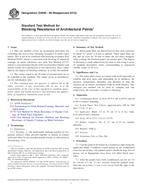Potrebujeme váš súhlas na využitie jednotlivých dát, aby sa vám okrem iného mohli ukazovať informácie týkajúce sa vašich záujmov. Súhlas udelíte kliknutím na tlačidlo „OK“.
ASTM D5031/D5031M-13
Standard Practice for Enclosed Carbon-Arc Exposure Tests of Paint and Related Coatings
Automaticky preložený názov:
Štandardná prax pre uzavretá Carbon-Arc expozičných testov s farbami a súvisiacich nátery
NORMA vydaná dňa 1.10.2013
Informácie o norme:
Označenie normy: ASTM D5031/D5031M-13
Poznámka: NEPLATNÁ
Dátum vydania normy: 1.10.2013
Kód tovaru: NS-29579
Počet strán: 6
Približná hmotnosť: 18 g (0.04 libier)
Krajina: Americká technická norma
Kategória: Technické normy ASTM
Kategórie - podobné normy:
Anotácia textu normy ASTM D5031/D5031M-13 :
Keywords:
carbon arc, degradation, exposure, light exposure, ultraviolet, weathering, ICS Number Code 87.040 (Paints and varnishes)
Doplňujúce informácie
| Significance and Use | ||||||||||||||||||||||||||||||||||||||||||||||||||||||||||||
|
4.1 The ability of a paint or coating to resist deterioration of its physical and optical properties caused by exposure to light, heat, and water can be very significant for many applications. This practice is intended to induce property changes associated with end-use conditions, including the effects of sunlight, moisture, and heat. The exposure used in this practice is not intended to simulate the deterioration caused by localized weather phenomena such as atmospheric pollution, biological attack, and saltwater exposure. 4.2 Cautions—Variation in results may be expected when different operating conditions are used. Therefore, no reference to the use of this practice shall be made unless accompanied by a report prepared according to Section 4.2.1 The spectral power distribution of light from an enclosed carbon arc is significantly different from that produced in light and water exposure devices using other carbon-arc configurations or other light sources. The type and rate of degradation and the performance rankings produced by exposures to enclosed carbon arcs can be much different from those produced by exposures to other types of laboratory light sources. 4.2.2 Interlaboratory comparisons are valid only when all laboratories use the same type of carbon arc, filters, and exposure conditions. 4.3 Reproducibility of test results between laboratories has been shown to be good when the stability of materials is evaluated in terms of performance ranking compared to other materials or to a control.4,5 Therefore, exposure of a similar material of known performance (a control) at the same time as the test materials is strongly recommended. It is recommended that at least three replicates of each material be exposed to allow for statistical evaluation of results. 4.4 Test results will depend upon the care that is taken to operate the equipment according to Practice G153. Significant factors include regulation of line voltage, freedom from salt or other deposits from water, temperature and humidity control, and conditions of the electrodes. 4.5 All references to exposures in accordance with this practice must include a complete description of the test cycle used. |
||||||||||||||||||||||||||||||||||||||||||||||||||||||||||||
| 1. Scope | ||||||||||||||||||||||||||||||||||||||||||||||||||||||||||||
|
1.1 This practice covers the selection of test conditions for accelerated exposure testing of coatings and related products in enclosed carbon arc devices operated according to Practices G151 and G153. This practice also covers the preparation of test specimens, the test conditions suited for coatings, and the evaluation of test results. 1.2 This practice does not cover filtered open-flame carbon-arc exposures of paints and related coatings, which is described in Practice D822/D822M. Another procedure for exposing these products is covered by Practice D3361/D3361M, in which the specimens are subjected to radiation from an unfiltered open-flame carbon arc that produces shorter wavelengths and higher levels of short wavelength radiation than filtered open flame or enclosed carbon arcs. 1.3 The values stated in either SI
units or inch-pound units are to be regarded separately as
standard. The values stated in each system may not be exact
equivalents; therefore, each system shall be used independently of
the other. Combining values from the two systems may result in
non-conformance with the standard.
1.4 This standard does not purport to address all of the safety concerns, if any, associated with its use. It is the responsibility of the user of this standard to establish appropriate safety and health practices and determine the applicability of regulatory limitations prior to use. |
||||||||||||||||||||||||||||||||||||||||||||||||||||||||||||
| 2. Referenced Documents | ||||||||||||||||||||||||||||||||||||||||||||||||||||||||||||
|
Podobné normy:
Historická
1.7.2013
Historická
1.2.2010
Historická
1.7.2014
Historická
1.6.2010
Historická
1.7.2012
Historická
1.12.2010



 ASTM D4707-09(2013)..
ASTM D4707-09(2013).. ASTM D4752-10
ASTM D4752-10 ASTM D4834-03(2014)..
ASTM D4834-03(2014).. ASTM D4838-88(2010)..
ASTM D4838-88(2010).. ASTM D4946-89(2012)..
ASTM D4946-89(2012).. ASTM D4958-10
ASTM D4958-10
 Cookies
Cookies
